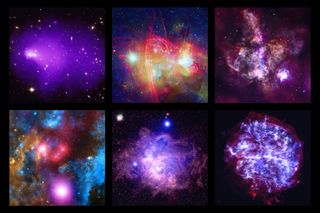It's been 20 years since NASA's Chandra X-Ray Observatory launched to give us the sharpest-ever view of X-rays — and the telescope is still working at the frontier of science, the agency said.
The observatory, named after the late Nobel laureate Subrahmanyan Chandrasekhar, an Indian American astrophysicist, launched on July 23, 1999. It hitched a ride to space aboard the shuttle Columbia and has orbited Earth and watched the sky ever since. To commemorate the big anniversary, NASA recently released six new Chandra images, showing everything from the light from infant stars to the structure of huge galaxy clusters.
"Chandra remains peerless in its ability to find and study X-ray sources," Belinda Wilkes, Chandra X-ray Center director, said in a statement. "Since virtually every astronomical source emits X-rays, we need a telescope like Chandra to fully view and understand our universe."
Related: X-Ray Universe: Amazing Photos by the Chandra X-Ray Observatory

A selection of images the Chandra X-Ray Observatory has gathered during its 20 years at work.
(Image credit: NASA/CXC)

Cygnus OB2 is full of massive, young stars that will die relatively quickly. Chandra data is shown in red and points of blue. Patches of blue were observed with the Newton telescope and orange data was gathered in the infrared by the Spitzer Space Telescope.
(Image credit: X-ray: NASA/CXC/SAO/J. Drake et al; H-alpha: Univ. of Hertfordshire/INT/IPHAS; Infrared: NASA/JPL-Caltech/Spitzer)

This image combines data from the Chandra X-Ray Observatory in blue and from the Hubble Space Telescope in purple of a star-forming region called NGC 604.
(Image credit: X-ray: NASA/CXC/CfA/R. Tuellmann et al.; Optical: NASA/AURA/STScI/J. Schmidt)

Chandra's view of a supernova remnant called G292.0+1.8, which contains an unusually large amount of oxygen.
(Image credit: NASA/CXC/SAO)

Abell 2146 is a massive structure that formed when two galaxy clusters collided. Chandra data is shown in blue overlaid on Hubble data.
(Image credit: X-ray: NASA/CXC/Univ. of Waterloo/H. Russell et al.; Optical: NASA/STScI)

A composite view of the center of the Milky Way shows Chandra data in green and blue. Red data was gathered by the MeerKAT telescope located in South Africa.
(Image credit: X-Ray:NASA/CXC/UMass/D. Wang et al.; Radio:NRF/SARAO/MeerKAT)

This massive star-forming region near the Milky Way, called 30 Doradus, is nicknamed the Tarantula Nebula. The data behind this image was gathered during 24 observation days over two years.
(Image credit: NASA/CXC/Penn State Univ./L. Townsley et al.)
Chandra's mission has evolved with our understanding of space. When it launched two decades ago, only a handful of exoplanets were known; today, Chandra routinely looks at how the radiation of stars affects the planets orbiting them. Gravitational waves (massive ripples in space-time) were only theory in 1999, but now Chandra observes the outcome of black hole mergers and other events that produce them.
The telescope is also engaged in observations that haven't yet made that transition, like the study of dark energy, a poorly understood phenomenon believed to make up much of our universe.
The idea for Chandra dates back more than 40 years, to the original proposal by Riccardo Giacconi and Harvey Tananbaum in 1976. Giacconi received the 2002 Nobel Prize for Physics due to his contributions in X-ray astronomy, and Tananbaum was the first director of the Chandra X-Ray Center, which operates the instrument.
The telescope is working well today after bouncing back from a gyroscope glitch in late 2018. It is expected to continue operations through at least 2024, with a possibility of two three-year contract options following that.
Follow Elizabeth Howell on Twitter @howellspace. Follow us on Twitter @Spacedotcom and on Facebook.
https://www.space.com/chandra-xray-telescope-turns-20.html
2019-07-28 12:11:00Z
CBMiOmh0dHBzOi8vd3d3LnNwYWNlLmNvbS9jaGFuZHJhLXhyYXktdGVsZXNjb3BlLXR1cm5zLTIwLmh0bWzSAT5odHRwczovL3d3dy5zcGFjZS5jb20vYW1wL2NoYW5kcmEteHJheS10ZWxlc2NvcGUtdHVybnMtMjAuaHRtbA
Bagikan Berita Ini















0 Response to "NASA Unveils Amazing Cosmic Views as Chandra X-Ray Observatory Turns 20 - Space.com"
Post a Comment